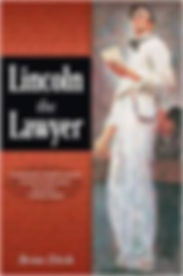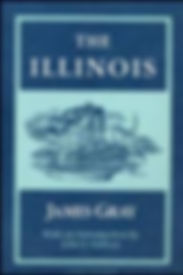Corn Kings and One-Horse Thieves
Odds & ends

Illinois past and present, as seen by James Krohe Jr.
The Corn Latitudes
A Book about Books about Illinois
Illinois! Illinois! reviewed
Illinois Times
November 9, 1979
For obvious reasons, I am touched by the situation of the forgotten author. I wrote about it here and in this review of a remarkable annotated bibliography of Illinois fiction. Rereading it, I was struck by how generous I was, but some readers of a curious sort will find Kilpatrick's guide an essential work.
Reviewed: Illinois! Illinois!: An Annotated Bibliography of Fiction by Thomas L. Kilpatrick (New Jersey: Scarecrow Press, 1979)
Among readers, books written by librarians tend to be little appreciated. The exception is reference works. Librarians write good reference books for the same reasons that ex-bank robbers make good security consultants: they know the business from the other side, and so know exactly what works and what doesn’t.
A new reference book that works wonderfully well has just been published by the Scarecrow Press, Inc., the pride of Metuchen. New Jersey. It is called, Illinois! Illinois! and it is billed as “an annotated bibliography of fiction.” It is that, to be sure: 1,554 entries, admirably organized, each introduced by annotations that seldom run more than 150 words—or need to. But what Illinois! Illinois! really is is a map to a little-traveled fictive landscape in which a century and a half of Illinois literature dwelled and whose crowded expanse until now was accessible only to the more adventuresome literary scholar.
Our industrious cartographers are Thomas L. Kilpatrick and Patsy-Rose Hoshiko. He is interlibrary loan librarian for ILLINET at Southern Illinois University at Carbondale; she is Interlibrary Cooperation project director for the Shawnee Library System at Carterville. The book was begun in 1971 when students in an SIU-C lit course compiled the names of some 395 works of Illinois fiction. Since then. Kilpatrick-Hoshiko have added hundreds more titles to the list, tracking their quarry through existing bibliographies and review collections, making notes about locale and character, reading each.
The result, is a fascinating grab bag, what Its publishers without a blush call “the most comprehensive work of this nature yet published.” I will not contradict them. The entries listed range from historical novels (including biographies) to short stories, and minor fiction of the- sort that used to be called women’s books. The compilers were equally catholic about period; the book is organized into five section corresponding to five major eras in Illinois history, from ‘Pre-Statehood Years” ending ‘in 1818 to “Modern Illinois,” which is here defined presciently as beginning in 1945 and ending in 1976. Entries within each section are arranged alphabetically by author. Each includes pertinent publication data (here one wishes for a little less librarian literalness, as some publication dates are given in Roman numerals after the pretentious fashion of some publishers), a summary of the plot where one was discernible (no mean feat in some cases, incidentally), observations on style and significance, and a reference to published reviews.
Through these means we are acquainted with such works as Lawrence Lynch’s 1894 Against Odds, in which two Secret Service agents find themselves tracking Greenback Bob and his ring of counterfeiters around the World’s Columbian Exposition (which K and H recommend for its “glowing account” of the Chicago fair). Also here is Horseshoe Bottoms. Tom Tippett’s 1935 account of coal mine organizing near Kickapoo Creek and the Illinois River in the 1870s.
Entry No. 1,490 is Rites of Passage, a 1966 novel by Jean Rikhoff. The book is one-third of a trilogy chronicling the Timble family of Springfield. The entry illustrates the strengths and occasional weaknesses of Illinois! Illinois! Its characterization of the book as “glaringly reminiscent of the daily soap operas” is accurate according to people who’ve read the book. (Sampler “‘Jules, lover, where is the gin?’ She threw her long lacquered hands up in excitement. ‘Oh, lover, I’m just dying for a little of the nectar of the gods.’) However, the compilers also congratulate Rikhoff for her “credible view of life in Illinois’s capitol city at mid-century,” even though her books have little local detail’ that is uniquely Springfieldian.
Entry No. 347 hints not at a weakness but an unacknowledged strength. The entry describes another novel, Mary Hartwell Catherwood’s The Dogberry Bunch, an 1879 effort that Kilpatrick and Hoshiko dismiss as “too sweet, too pat and too prosaic to be read today,” but which nonetheless “is representative of the type of periodical literature read by millions of Americans during the nineteenth century.” There is a hint here of the reasons this bibliography is of use to more than literary scholars and may serve historians, sociologists, political scientists, and others equally well. How? In an essay on the work of critic Lionel Trilling that appeared recently in The New Yorker, Richard Sennett observed that Trilling believed, “Writing . . . provides insights into moral problems in politics, psychology, and manners which can be gained in no other way.” “This view,” Sennett notes, “made literature more than a text.” This link between fiction and the world makes 1llinois! Illinois! more than a Baedeker to bad novels. It is an index to the accumulated experience of 150 years of state-building as recorded by artists who sought, with wildly varying success, to reorder and express that experience in story. ●
SITES
OF
INTEREST
Essential for anyone interested in Illinois history and literature. Hallwas deservedly won the 2018 Lifetime Achievement Award from the Illinois State Historical Society.
One of Illinois’s best, and least-known, writers of his generation. Take note in particular of The Distancers and Road to Nowhere.
See Home Page/Learn/
Resources for a marvelous building database, architecture dictionary, even a city planning graphic novel. Handsome, useful—every Illinois culture website should be so good.
The online version of The Encyclopedia of Chicago. Crammed with thousands of topic entries, biographical sketches, maps and images, it is a reference work unmatched in Illinois.
The Illinois chapter of the American Institute of Architects in 2018 selected 200 Great Places in Illinois that illustrate our shared architectural culture across the entire period of human settlement in Illinois.
A nationally accredited, award-winning project of the McLean County Historical Society whose holdings include more than 20,000 objects, more than 15,000 books on local history and genealogy, and boxes and boxes of historical papers and images.
Mr. Lincoln, Route 66, and Other Highlights of Lincoln, Illinois
Every Illinois town ought to have a chronicler like D. Leigh Henson, Ph.D. Not only Lincoln and the Mother road—the author’s curiosity ranges from cattle baron John Dean Gillett to novelist William Maxwell. An Illinois State Historical Society "Best Web Site of the Year."
Created in 2000, the IDA is a repository for the digital collections of the Illinois State Library and other Illinois libraries and cultural institutions. The holdings include photographs, slides, and glass negatives, oral histories, newspapers, maps, and documents from manuscripts and letters to postcards, posters, and videos.
The people's museum is a treasure house of science and the arts. A research institution of national reputation, the museum maintains four facilities across the state. Their collections in anthropology, fine and decorative arts, botany, zoology, geology, and history are described here. A few museum publications can be obtained here.
“Chronicling Illinois” showcases some of the collections—mostly some 6,000 photographs—from the Illinois history holdings of the Abraham Lincoln Presidential Library.
I will leave it to the authors of this interesting site to describe it. "Chicagology is a study of Chicago history with a focus on the period prior to the Second World War. The purpose of the site is to document common and not so common stories about the City of Chicago as they are discovered."
Illinois Labor History Society
The Illinois Labor History Society seeks to encourage the preservation and study of labor history materials of the Illinois region, and to arouse public interest in the profound significance of the past to the present. Offers books reviews, podcasts, research guides, and the like.
Illinois Migration History 1850-2017
The University of Washington’s America’s Great Migrations Project has compiled migration histories (mostly from the published and unpublished work by UW Professor of History James Gregory) for several states, including Illinois. The site also includes maps and charts and essays about the Great Migration of African Americans to the north, in which Illinois figured importantly.
An interesting resource about the history of one of Illinois’s more interesting places, the Fox Valley of Kendall County. History on the Fox is the work of Roger Matile, an amateur historian of the best sort. Matile’s site is a couple of cuts above the typical buff’s blog. (An entry on the French attempt to cash in on the trade in bison pelts runs more than
2,000 words.)
BOOKS
OF INTEREST

Southern Illinois University Press 2017
A work of solid history, entertainingly told.
Michael Burlingame,
author of Abraham
Lincoln: A Life
One of the ten best books on Illinois history I have read in a decade.
Superior Achievement Award citation, ISHS Awards, 2018
A lively and engaging study . . . an enthralling narrative.
James Edstrom
The Annals of Iowa
A book that merits the attention of all Illinois historians
as well as local historians generally.
John Hoffman
Journal of Illinois HIstory
A model for the kind of detailed and honest history other states and regions could use.
Harold Henderson
Midwestern Microhistory
A fine example of a resurgence of Midwest historical scholarship.
Greg Hall
Journal of the Illinois
State Historical Society
Click here
to buy the book
Southern Illinois University Press
SIU Press is one of the four major university publishing houses in Illinois. Its catalog offers much of local interest, including biographies of Illinois political figures, the history (human and natural) and folklore of southern Illinois, the Civil War and Lincoln, and quality reprints in the Shawnee Classics series.
The U of I Press was founded in 1918. A search of the online catalog (Books/Browse by subject/Illinois) will reveal more than 150 Illinois titles, books on history mostly but also butteflies, nature , painting, poetry and fiction, and more. Of particular note are its Prairie State Books, quality new paperback editions of worthy titles about all parts of Illinois, augmented with scholarly introductions.
The U of C publishing operation is the oldest (1891) and largest university press in Illinois. Its reach is international, but it has not neglected its own neighborhood. Any good Illinois library will include dozens of titles about Chicago and Illinois from Fort Dearborn to
Vivian Maier.
Northern Illinois University Press
The newest (1965) and the smallest of the university presses with an interest in Illinois, Northern Illinois University Press gave us important titles such as the standard one-volume history of the state (Biles' Illinois:
A History of the Land and Its People) and contributions to the history of Chicago, Illinois transportation, and the Civil War. Now an imprint of Cornell University Press.




Reviews and significant mentions by James Krohe Jr. of more than 50 Illinois books, arranged in alphabetical order
by book title.
Run by the Illinois State Library, The Center promotes reading, writing and author programs meant to honor the state's rich literary heritage. An affiliate of the Library of Congress’s Center for the Book, the site offers award competitions, a directory of Illinois authors, literary landmarks, and reading programs.
